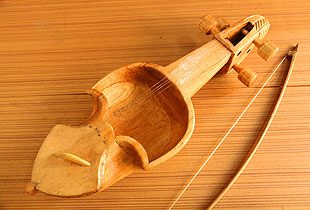Price of Sarangi in Nepal in 2025

Introduction
Table of Contents
ToggleThe sarangi is a powerful symbol of tradition, storytelling, and cultural identity. Originally, it is an musical instrument of the Gandarbha community. In the current scenario, it has evolved from a village folk instrument to a key part of modern Nepali music. Here is all the information about the price of sarangi in Nepal, with its introduction as well.
What is Sarangi
The sarangi is a traditional Nepali music instrument. It is known for its deep, emotional and unique sound. It is made from a single block of wood and played with a bow. The sarangi has four main strings that are held vertically while played. The player used their left hand fingers to press the strings and their right hand to move the bow.
Sarangi is traditionally connected with the Gandarbha (or Gaine) community. They used it to tell stories, share news and preserve oral history through song.
Cultural importance of Sarangi
Sarangi is a musical instrument, but it serves more than just music. It is a part of storytelling, a symbol of identity and a vital instrument of Nepal’s musical heritage. Here is a closer look at the cultural importance of the sarangi in Nepali music.
Medium of News Distribution
Before the age of social media. At that time, Gandarbha musicians used the Sarangi to sing songs. The songs shared local news and current events through travel from village to village by singing the song.
Cultural Identity
The sarangi is a crucial part of the Gandarbha (Gaine) community. For them, the sarangi is more than a livelihood. It is a symbol of ancestral pride, artistic skills and cultural heritage. The Gandarbha (Gaine) community passed down the art of playing and crafting the sarangi.
Emotional Connection
Initially, sarangi was used for news and storytelling. Most of the stories are about the reality of society. So, audiences feel and connect with the stories. a genuine emotion while
Adaptation and continuity
Sarangi was once considered an instrument of the lower caste. Now it has found its place in Nepali music. The younger generation is preserving, modernising and globalising the traditional instruments. Today, the sarangi is an example of cultural continuity. It shows how tradition can evolve without being lost.
Construction of Sarangi
The sarangi is a beautifully handcrafted instrument. It was originally made using natural materials from the local forest and animals. Every part of the sarangi contributes to its sound and cultural authenticity.
Types of Wood Used
Sarangies are carved from a single piece of wood. The choice of wood affects the quality, tone and longevity of the instrument. The most common types of wood used in Nepal are:
- Sisso (Rosewood)-Known for durability and warm tone
- Khirro (Sapium insigne) – Lightweight and easy to shape, common in traditional sarangis.
Strings materials
The sarangi has four main strings. Their construction has evolved with time.
Traditional Strings: Originally made from sheep or goat intestine.
Modern String: Today, strings are made by using nylon, steel, or badminton racket strings.
Bow materials
Traditional bows were made from house tail hair.
Modern bows use nylon hair.
How to Play the Sarangi?
There are different methods of producing notes on the Sarangi. The Gandarbha community played the sarangi through the coordination between the left hand for notes and the right hand for bowing.
Left Hand Technique
The left hand is used to press the strings to create different notes. Sarangi players use the nail edges and the sides of the fingers to touch the strings lightly. Mastering finger placement is crucial.
Right Hand Technique
The right hand holds the bow and moves it horizontally across the strings.
Traditional vs. modern playing style
Traditional Style:
- Played on narrative songs and oral storytelling
- Players continuously bow while singing
- Focused on folk rhythms and melodic simplicity
Modern Style
- Adopted into contemporary genres like Nepali pop, fusion, and film music
- Uses a microphone, modern strings
- Played with instruments like guitar, tabla, and keyboards
Price of Sarangi in Nepal 2025
The price of Sarangi varies with its quality.
| Type / Description | Price (NPR) |
|---|---|
| Medium-size / Folk Sarangi (basic) | ₨ 3,500 |
| Handmade 26-inch Sarangi | ₨ 4,500 |
| “Big size” / large Sarangi (Daraz listing) | ₨ 3,000 – ₨ 5,000 (e.g. ₹3,000 & ₹5,000 entries) |
| Handmade / heavier Sarangi (Sukumart) | ₨ 11,000 |
| Professional-quality handmade Sarangi (Nepal Music Gallery) | ₨ 20,000 |
Factors that affect the price of sarangi
The price of sarangi is influenced by several factors:
- Material Quality
- Craftsmanship
- Playability
- Size and Customizations
- Seller and Source
Where to buy a sarangi in Nepal
Nowadays, with the rise of online and offline stores, finding a sarangi isn’t hard. The major hardship is finding one of good quality. If you can access an offline store, visit that. If you are looking for an online store, then Swodeshi Nepal is the perfect place for sarangi.
Why you should buy your Sarangi from Swodeshi
Swodeshi is an online store that promotes Nepali authentic products in Nepal and abroad. The purpose of Swodesh is to promote Nepali culture and unique traditions through various Nepali products.
- Handpicked directly from artisans
Swodeshi sources its Sarangis directly from the original makers of the instruments. Gandarbha artisans.
- Transparent product details with an Affordable price
Swodeshi offers Sarangis at fair and competitive prices along with clear product details. There are no hidden costs. You get great value for your money.
- Nationwide delivery
Whether you are in Kathmandu or a remote district, Swodeshi provides fast delivery services across the world
- International shipping
Swodeshi also offers international delivery to selected countries. Whether you live abroad and want to reconnect with Nepali culture or share it with others, now, you can easily order a Sarangi and have it shipped overseas.
- Quality Assurance
Every product listed on Swodeshi goes through a quality check to ensure its quality.
- Promote Culture with Products
You are not just purchasing an instrument from Swodeshi Nepal. You’re supporting a mission to preserve Nepali art, music, and tradition.
Tips for Buyers
No matter why you’re buying a sarangi, it is important to check a few key details to ensure you’re getting value, quality, and authenticity.
Check the Wood Quality
Both the condition and type of wood directly affect the sound, durability, and appearance of the Sarangi. Look for the Sarangis made from seasoned hardwoods such as:
- Sissoo
- Khirro
- Saaj
Test the Sound
If you are buying offline:
- A good Sarangi should produce a warm, rich, and resonant tone.
- Try playing it by yourself or ask an expert to test.
If you’re buying online:
- Read product descriptions carefully to understand the tone and playability.
Conclusion
The Sarangi is not only an instrument. It is a piece of art, a history of the gandarbha community, a medium of news distribution and storytelling. Sarangi is a true gem of the Nepali music industry. The Sarangi itself is a symbol of the Cultural Revolution. The Gandarbha society preserved and passed its history from generation to generation. Now, it is our duty to preserve history and art.
FAQ on Price of Sarangi in Nepal
What is the price of a Sarangi in Nepal?
The price of a sarangi in Nepal ranges from NPR 3,000 to NPR 35,000+, depending on the quality, craftsmanship, and size. Basic models cost around NPR 3,000–5,000, while professional handmade sarangis can cost up to NPR 20,000.
What is the price of a Sarangi?
The price of a sarangi varies by region and quality. In general:
-
In Nepal: NPR 3,000 to NPR 35,000+
-
On Amazon or international markets: USD 140 to USD 200+
Hand-carved sarangis made with traditional methods are usually more expensive.
What is Sarangi in Nepal?
The Nepali Sarangi is a traditional bowed string instrument made of carved wood (often khirro), a skin-covered soundboard, and traditionally gut strings (now often nylon/steel).
It is deeply connected to Nepali folk music, especially Gandharva/ Gaine storytelling traditions.
Which caste is Sarangi associated with in Nepal?
The Sarangi is traditionally associated with the Gandharva (Gaine) caste of Nepal, who used it for narrative singing, news-telling, and folk performances.
How much money does a Sarangi player make?
Income varies widely. A rough overview:
-
Local folk/ghazal performer: NPR 10,000–30,000/month
-
Event/Stage performer: NPR 3,000–15,000 per event
-
Professional/recording artists: Can earn more through concerts, festivals, and royalties.
-
International performers: Often earn significantly higher depending on tours and collaborations.
(These are general estimates; actual income depends on skill, location, and performance demand.)
What are the 4 types of musical instruments?
The traditional classification (Indian/Nepali & global music theory) lists four main types:
-
String instruments (Chordophones) – e.g., Sarangi, Guitar, Violin
-
Wind instruments (Aerophones) – e.g., Bansuri, Trumpet
-
Percussion instruments (Membranophones/Idiophones) – e.g., Madal, Tabla, Drums
-
Electronic instruments (Electrophones) – e.g., Synthesiser, Electric guitar
Is Sarangi difficult to play?
Yes, it is considered one of the more challenging folk instruments because:
-
Playing uses no frets, like a violin
-
Notes must be found precisely by ear
-
Bowing requires control and precision
-
Traditional Sarangi strings are sensitive to pressure
But with practice, it becomes very expressive and soulful.
What are the top 10 most popular musical instruments?
Globally recognized as most popular:
-
Guitar
-
Piano
-
Violin
-
Drums
-
Flute
-
Ukulele
-
Saxophone
-
Keyboard/Synth
-
Tabla / Drums (South Asia)
-
Harmonica
(Popularity varies by region.)
Is Sarangi older than the violin?
Yes, Sarangi and similar bowed instruments in South Asia existed before the modern violin.
The modern violin developed in 16th-century Italy, while South Asian bowed instruments date back at least to the 10th–12th century.
Sarangi, as we know it toda,y developed earlier than the European violin.
What is a 72-stringed instrument?
A “72-string instrument” usually refers to:
-
Qanun (Kanun) – Middle Eastern instrument with 72–78 strings
-
Some multi-string harps and zithers may also use 72 strings
-
Not related to the Nepali Sarangi (which typically has 3–4 strings)
What is Sarangi called in English?
There is no separate English word for Sarangi.
It is simply called: “Sarangi”
Or sometimes described as a “Nepalese bowed lute.”
How useful was this post?
Click on a star to rate it!
Average rating 5 / 5. Vote count: 1
No votes so far! Be the first to rate this post.
Recent Posts
Featured Products
-
 Ashtamangal Puja Thali
NPR 690
Ashtamangal Puja Thali
NPR 690
-
 Ashtamangal mandap
NPR 1,790
Ashtamangal mandap
NPR 1,790
-
 Ganesh Sukunda - Traditional Oil Lamp 7"
NPR 4,600
Ganesh Sukunda - Traditional Oil Lamp 7"
NPR 4,600
-
 Gold-Plated Aparmita Statue
NPR 55,000
Gold-Plated Aparmita Statue
NPR 55,000
-
 Gold Plated Sahasar Bhuj Lokeshwor Statue
NPR 69,000
Gold Plated Sahasar Bhuj Lokeshwor Statue
NPR 69,000
-
 Gold Plated Namgyal Statue
NPR 33,600
Gold Plated Namgyal Statue
NPR 33,600




